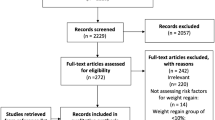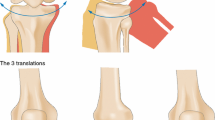Abstract
This CORR Insights™ is a commentary on the article “Do Patients Lose Weight After Joint Arthroplasty Surgery? A Systematic Review” by Inacio and colleagues available at DOI 10.1007/s11999-012-2537-7.
Similar content being viewed by others
Where are we now?
Total joint replacement is a highly successful surgical procedure that decreases pain, and improves function, mobility, and psychosocial well being for patients with end-stage arthritis of the hip and knee. Obesity is highly prevalent in our society and a known risk factor for the development of osteoarthritis and other serious medical conditions. Obese patients frequently tell clinicians that they are overweight because their painful hips or knees limit their physical activities and their capability to “burn calories”. If this were the case, then replacement of the arthritic joint should relieve the pain, rendering the patient more physically active. This would allow the patient to make better lifestyle choices including becoming more physically fit and losing excess weight. The byproducts of weight loss could have substantial positive consequences, including less painful arthritis in other weightbearing joints, and decreased incidence of diabetes, hypertension, and other comorbid diseases. Inacio and colleagues performed a systematic review (meta-analysis) to determine whether total joint arthroplasty of the lower extremity is associated with subsequent weight loss. Only studies published in the English literature were reviewed. Unfortunately, after a comprehensive analysis of the data, the answer to this important question is still unknown. Why is this so? The main reasons include a paucity of high-quality studies, which tend to be small, highly variable, and biased.
Where do we need to go?
To answer the question posed above, a sufficiently large, focused study needs to be performed which includes a well-defined subpopulation of patients (such as those who are overweight or obese who are undergoing total knee replacement for unilateral osteoarthritis) and clearly specified definitions, methodology, and outcome variables. Numerous potential biases (including selection bias, measurement bias, attrition bias) need to be anticipated and documented. Confounding variables need to be addressed. For example, patients with arthritis of the foot and ankle, serious medical comorbidities hampering ambulation, or known endocrine disorders may not be able to participate in physical activities adequately to lose weight.
How do we get there?
Not all patients undergoing joint replacement need to lose weight. The subject of weight loss after total joint replacement should be broadened to include starting (presurgical) and ending weight (at a specific time), ideal weight (perhaps BMI), and patients’ expectations. The method of counseling the patient regarding his or her weight should be clearly defined and incorporated into an algorithm for treatment before and after surgery. A suitable end point, perhaps 2 years after surgery. would allow the patient to obtain the necessary resources to accomplish weight goals, after the period of convalescence and rehabilitation. To maximize success, a team approach would appear be optimal and include the orthopaedic medical and nursing team, physical therapist, nutritionist, psychologist/psychiatrist, and statistical consultants. This approach is comparable to the cardiac rehabilitation teams that have had success in improving patient lifestyles after various heart ailments. This study may lend itself to multi-institutional and even multinational enrollment to obtain principles and conclusions that would be generalizable to different national and ethnic populations.
Author information
Authors and Affiliations
Corresponding author
Additional information
The author certifies that he or she, or a member of his or her immediate family, has no funding or commercial associations (eg, consultancies, stock ownership, equity interest, patent/licensing arrangements, etc) that might pose a conflict of interest in connection with the submitted article.
All ICMJE Conflict of Interest Forms for authors and Clinical Orthopaedics and Related Research editors and board members are on file with the publication and can be viewed on request.
About this article
Cite this article
Goodman, S.B. CORR Insights: Do Patients Lose Weight After Joint Arthroplasty Surgery? A Systematic Review. Clin Orthop Relat Res 471, 299–300 (2013). https://doi.org/10.1007/s11999-012-2538-6
Received:
Accepted:
Published:
Issue Date:
DOI: https://doi.org/10.1007/s11999-012-2538-6




